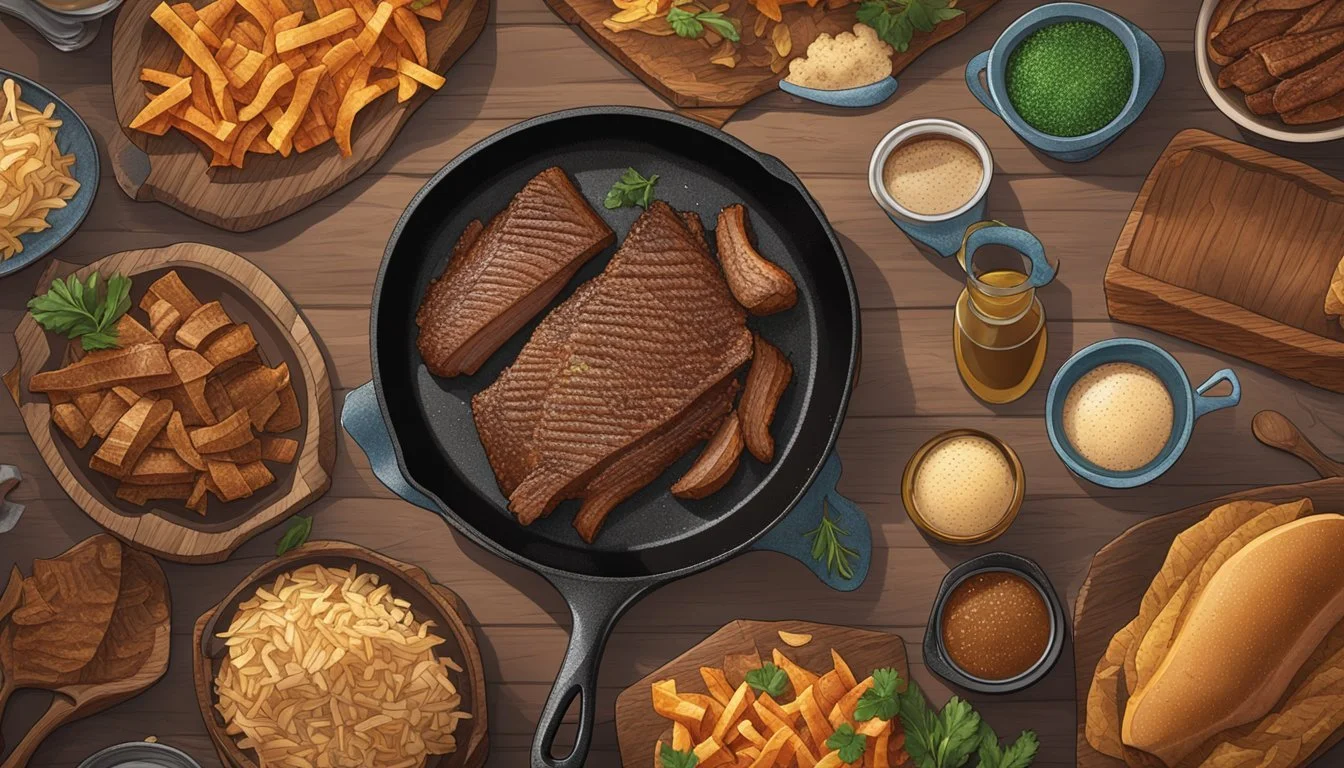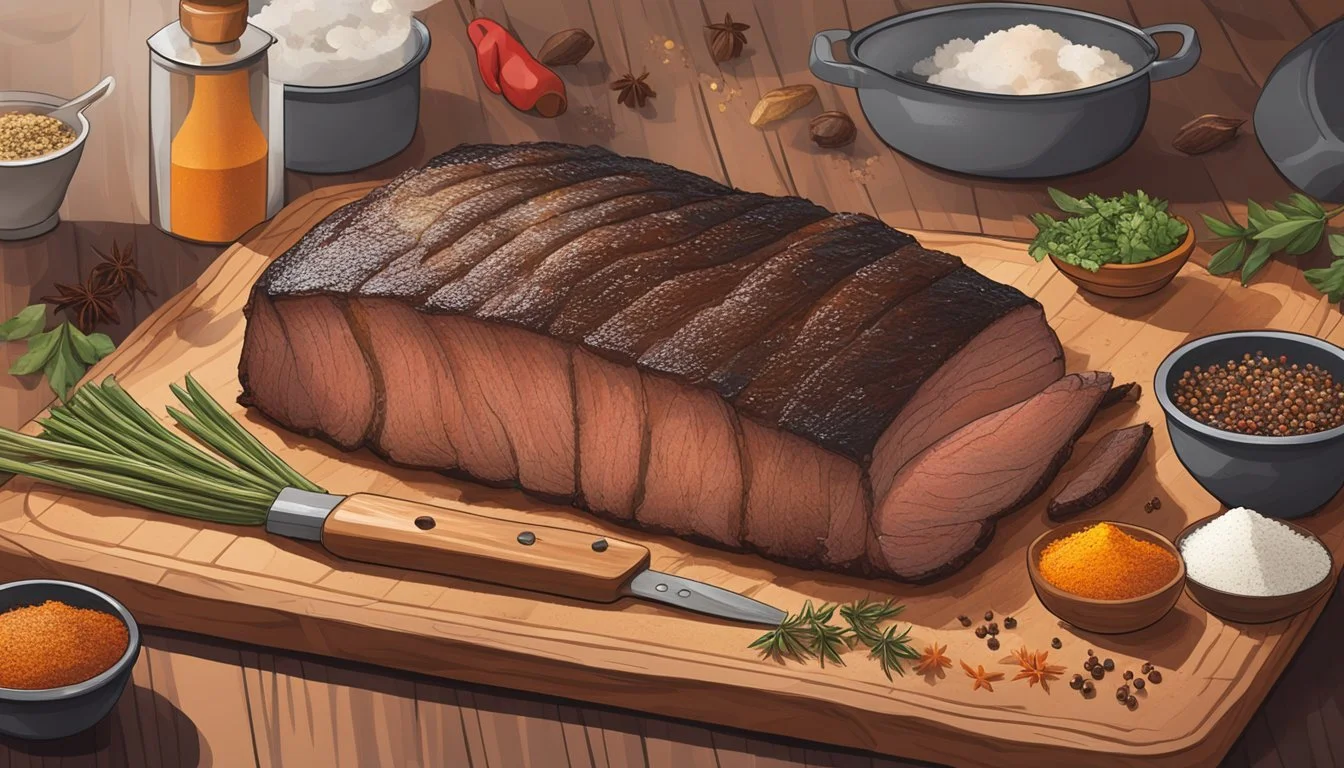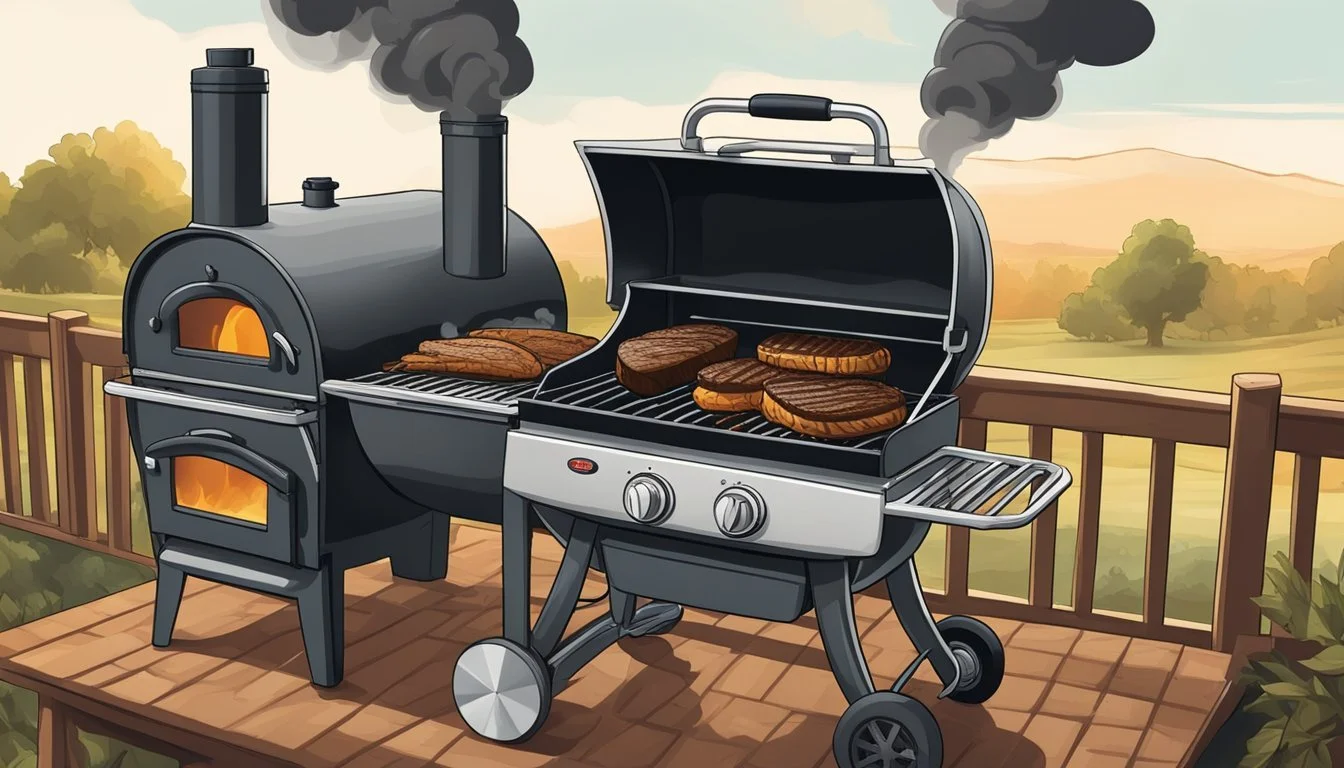The Stovetop Smoked Brisket
Indoor BBQ Mastery Techniques
The allure of tender, smoky brisket isn't reserved for outdoor barbecues (What wine goes well with barbecue?) and smokehouses. Home cooks can replicate the savory, complex flavors of a slow-cooked brisket right on their stovetop. The process harnesses the power of combined cooking methods, merging the convenience of indoor appliances with traditional smoking techniques. The secret lies in effectively creating a smoke-infused environment that can be achieved even without a dedicated smoker.
Executing a stovetop smoked brisket begins with seasoning the meat, ensuring each fiber is permeated with flavor. The brisket is then seared to seal in juices and create a crusty exterior. Various cooking vessels, like the Instant Pot or a Dutch oven, play crucial roles in the braising process, guaranteeing a tender and moist result. Infusing liquids like broth or wine alongside aromatic vegetables further enhances the meat's flavor profile, paying homage to the low and slow ethos of barbecue tradition.
Though the method may seem unorthodox to pitmasters, the stovetop smoked brisket breaks the boundaries of conventional barbecue. It allows enthusiasts to explore the realm of slow-cooked, smoky meats without relying on outdoor equipment. While the brisket bathes in a low-temperature oven to continue its journey to tenderness, cooks can anticipate an indoor barbecue experience that stands up to its open-air counterpart.
What Is Stovetop Smoked Brisket?
Stovetop smoked brisket brings the rich flavors of traditional barbecue to the kitchen, offering a method to smoke beef brisket indoors using a stovetop smoker or alternative cooking techniques.
Defining the Dish
Stovetop smoked brisket is a culinary adaptation of the classic barbecue dish, typically prepared using a cut from the lower chest or breast of beef. This technique involves creating a smoke-filled environment within a stovetop setup, allowing the brisket to absorb smoky flavors (What wine goes well with smoky flavors?) without the need for an outdoor smoker. In its essence, this dish replicates the tenderizing and flavor-enhancing process of traditional smoking, using liquid smoke, wood chips, or similar elements that infuse the meat with a barbecue-like taste.
Origins and Cultural Significance
The origins of smoked brisket trace back to indigenous practices of preserving meats and were later adopted in various global barbecue traditions, most notably in Texas barbecue where brisket holds a place of honor. While traditional smoking relies on a lengthy process over indirect heat and smoke outdoors, stovetop smoking evolved from the desire to recreate these flavors indoors, especially in urban settings or regions with climate constraints. It reflects adaptability in culinary practices, ensuring that the cultural significance of enjoying smoked brisket is accessible to more people in varied living situations.
Selecting the Right Cut
When preparing stovetop smoked brisket, choosing the right cut is crucial for achieving the ideal balance of flavor and tenderness. The cut's fat content and how it is positioned during cooking can significantly influence the end result.
Brisket Anatomy
Brisket comes from the lower chest or pectoral muscles of the cow. It's composed of two main parts: the flat, which is the leaner section that provides uniform slices, and the point, a thicker, fattier part that's rich with marbling. The entire brisket has a cap of fat that varies in thickness across the cut.
Lean vs. Fat Side Up
The debate between cooking brisket with the lean side or fat side up is often about preference and the cooking method used.
Fat Side Up: Advocates for fat side up believe that as the fat renders, it naturally bastes the meat, keeping it moist. However, on the stovetop, this can be less effective since the rendering fat doesn't drip down onto the brisket as it would in a grill.
Lean Side Up: Cooking with the lean side up can be advantageous for stovetop smoking, as it allows the meat to form a crust that traps moisture and flavor. Most smoking methods employ indirect heat, but stovetop cooking is direct; hence, the brisket benefits from being cooked lean side up to prevent the fat from burning before the meat is fully cooked.
Preparation Before Cooking
Before cooking begins, the brisket must be adequately prepped to ensure the best flavor. This preparation involves careful trimming, the application of a well-balanced dry rub, and if desired, a brining process for enhanced moisture and taste.
Trimming the Brisket
One begins by removing the brisket from refrigeration. Using a sharp knife, one should trim the excess fat, aiming for a uniform thickness of about 1/4 inch. It's important to trim judiciously to maintain moisture during the cooking process, especially at the point where the flat and point sections meet.
Applying a Dry Rub
After trimming, a dry rub imparts rich flavors and helps form a desirable crust, also known as 'bark'. A typical dry rub might include:
Salt: essential for flavor enhancement
Garlic powder: for a pungent depth
Paprika: which adds a light smokiness and color
Black pepper: for a spicy kick
Yellow mustard powder: that ties the flavors together
Each spice should be used judiciously, applying a generous coating evenly over the entire surface of the brisket.
Brining the Meat
Brining is optional but recommended for infusing the brisket with additional moisture and flavor. A simple brine can be made by dissolving salt in water, often with added spices to mirror those used in the dry rub. The brisket should be submerged in the brine and left to soak, refrigerated, for several hours or overnight.
Creating Indoor Smoke
To achieve the authentic taste of smoked brisket indoors, one needs the right techniques and ingredients. The essence of smoking lies in the wood used and the alternatives that can mimic the smoky flavor.
Choosing Smoking Wood
For indoor smoking, the choice of wood is crucial as each type imparts a unique flavor to the meat. Oak and hickory are classic options, providing a robust profile, while wood from fruit trees like apple and cherry offer a sweeter, milder essence. It is essential to use smaller wood chips or chunks to control smoke levels and avoid overpowering the brisket.
Oak: A traditional choice that imparts a strong, but not overpowering, smoky flavor.
Hickory: Known for a hearty and savory smoke profile.
Apple: Provides a subtle, sweet flavor, perfect for balancing the brisket's richness.
Cherry: Yields a mild, fruity smoke that can enhance the brisket's overall taste.
Smoke Alternatives
If real wood chips are not an option, liquid smoke offers a convenient alternative. Just a small addition of liquid smoke to a marinade or sauce can infuse the brisket with the desired smoky flavor without the need for actual smoke.
Liquid Smoke: A concentrated solution that delivers smokiness with just a few drops.
In the absence of traditional smoking methods, these alternatives allow for the creation of a flavorful, smoky brisket indoors.
The Smoking Process on a Stovetop
Creating a smoky, barbecue flavor indoors is achievable through the use of a stovetop smoker. The method involves a careful setup of kitchen equipment to mimic outdoor smoking conditions.
Setting Up Your Stovetop Smoker
One begins the stovetop smoking process by lining the smoker's drip tray with aluminum foil for easy cleanup. The brisket, already prepared and seasoned, is then placed on the smoker's rack above the tray. To capture smoke, the chamber is usually sealed with a lid or aluminum foil. Chips of hardwood, chosen for the desired smoke flavor, are spread on the bottom of the smoker. As heat turns these chips into smoke, they impart a smoky essence to the meat.
Managing Heat and Smoke
Maintaining consistent heat is critical for proper smoking. Typically, the heat is kept medium to low, as the goal is to envelop the brisket in smoke, not to cook it through aggressively. It's essential for the cook to monitor the kitchen stove, adjusting as necessary to maintain a steady temperature and avoid burning the wood chips. The process can take a couple of hours—during which the kitchen may gradually fill with a smoky aroma indicative of the flavor being imparted to the brisket.
Cooking the Brisket to Perfection
Cooking a brisket to perfection on the stovetop involves carefully monitoring the meat's internal temperature, understanding the stalling phase during cooking, and employing proper wrapping techniques to retain moisture.
Monitoring the Temperature
Using a meat thermometer, one tracks the internal temperature of the brisket to ensure it's cooked safely and to the desired level of tenderness. Initially, the brisket should spend about 1 ½ hours in the stovetop smoker at a medium to low setting before transferring to the oven. Once in the oven, a cook maintains the temperature around 275°F (135°C), regularly checking the meat's internal temperature which should reach approximately 190-203°F (88-95°C) for ideal tenderness.
Start: Medium to low heat on stovetop smoker
Range: Maintain oven at 275°F (135°C)
End Goal: Internal temperature of 190-203°F (88-95°C)
Understanding the Stall
The stall, a phase where the brisket's temperature plateaus, can cause concern but is a normal part of the cooking process. This occurs typically when the meat reaches an internal temperature range of 150-170°F (65-77°C). It is caused by moisture evaporating from the meat's surface and cooling it down, similar to the effect of sweat on skin. Recognizing this phenomenon, chefs allow the brisket to work through the stall without drastically altering the cooking temperature or method.
Stall Range: 150-170°F (65-77°C)
Cause: Evaporative cooling
Action: Maintain consistent cooking method
Wrapping Techniques
Wrapping the brisket, often referred to as the Texas crutch, can help push through the stall phase and lock in moisture. After the stall, one can wrap the brisket in foil or butcher paper, then return it to the oven to finish cooking. This method helps to accelerate the final phase of cooking by trapping heat and reducing evaporative cooling.
Wrap Material: Foil (Texas crutch) or butcher paper
When to Wrap: After the brisket experiences the stall
Purpose: Retain moisture, trap heat, and reduce cooking time
Resting and Carving
After smoking your brisket on the stovetop, it's essential to follow proper resting and slicing techniques to ensure the meat retains its succulent BBQ flavors and tender texture.
The Importance of Resting
Resting the brisket is a critical step one shouldn't skip. This period allows the brisket to reabsorb its juices, redistributing them throughout the meat. Specifically, resting should happen when the brisket reaches an internal temperature of approximately 160°F. Here's how to do it:
Remove the brisket from heat.
Tent with aluminum foil to maintain warmth.
Let it rest for 1 hour at minimum, although a duration of up to 2 hours can be beneficial for larger cuts.
During this time, the brisket continues to cook slightly due to residual heat, enhancing its overall juiciness.
Slicing for Maximum Juiciness
The brisket is composed of two different muscles with grains running in different directions, making slicing it correctly a task that should be approached with care. Here's the method:
Identify the point and the flat. The point is fattier and the flat is leaner.
Separate these two muscles by cutting horizontally between them.
Slice the flat against the grain into pencil-width slices for the best texture.
For the point, which is often used for burnt ends, chop into cubes or slice as desired.
By slicing against the grain, one shortens the muscle fibers, which leads to a more tender bite that is easier to chew.
Using the right technique during the resting and carving stages is just as important as the cooking process itself for stovetop smoked brisket. These steps ensure that each slice is as juicy and flavorful as possible.
Sauces and Accompaniments
When one prepares stovetop smoked brisket, the choice of sauces and side dishes can either complement or enhance the deep flavors developed through the smoking process. Certain sauces may bring out the smokiness, while others add a contrasting tang or sweetness. Side dishes offer a balance in texture and rhythm to each bite.
Selecting a BBQ Sauce
A successful BBQ sauce for stovetop smoked brisket melds well with the meat's rich flavors. One can opt for store-bought varieties, looking for labels that mention "smoky," "balanced," or "rich." A sauce containing apple cider vinegar can provide a tang that cuts through the fat, while a touch of liquid aminos or soy sauce can add depth.
Crafting Homemade Sauces
For enthusiasts, homemade BBQ sauces present an opportunity for customization. Begin with a base of tomato sauce or ketchup, integrate sweetness with brown sugar or maple syrup, and then layer complexity with liquid aminos or a splash of apple cider vinegar for brightness. Worcestershire sauce is optional but recommended for its umami.
Example Recipe:
Tomato sauce (1 cup)
Dark brown sugar (1/4 cup)
Apple cider vinegar (2 tbsp)
Liquid aminos or soy sauce (1 tbsp)
Maple syrup (optional, 1 tbsp)
Beef broth (for depth, 1/2 cup)
Worcestershire sauce (1 tsp)
Mix and simmer these ingredients, adjusting quantities to taste.
Pairings and Side Dishes
Choosing the right side dishes for brisket is crucial in creating a well-rounded meal. Classic pairings include:
Coleslaw: Offers a crisp, refreshing counterpoint.
Cornbread: Adds a subtle sweetness and a soft texture against the brisket.
Baked beans: Provide a hearty, savory component that complements the main dish.
Grilled vegetables: (What wine goes well with grilled vegetables?) Brings a charred, smoky flavor mirroring that of the brisket.
Advanced Tips and Techniques
In creating stovetop smoked brisket, understanding advanced techniques ensures the flavor complexity and texture that can rival outdoor smoking. These tips come from experimenting at home and advice from established pitmasters.
Using a ChefSteps Approach
ChefSteps, known for their precise and innovative cooking techniques, suggests leveraging modern kitchen tools to replicate the smoker environment. One indoor smoking method involves a stovetop smoker—a device that allows wood chips to smolder and produce smoke, enveloping the meat in flavorful fumes. For a stovetop smoker, it's essential to:
Use a well-sealed pan or a dedicated stovetop smoker.
Choose wood chips that complement the brisket, like hickory or mesquite.
Control the heat meticulously to maintain a consistent smoking temperature.
Advice from Pitmasters
Pitmasters contribute their expertise with indirect grilling techniques and the importance of maintaining proper temperature and smoke flow. They emphasize:
Temperature Control: Keep a consistent low heat to mimic the slow cooking of a smoker.
Aim for a brisket internal temperature of around 195°F to 205°F for optimum tenderness.
Tools for Success: Use tools like a meat thermometer and a spray bottle with apple cider vinegar to monitor and enhance the cooking process.
A thermocouple or probe thermometer ensures accurate brisket temperature readings.
Spritzing with apple cider vinegar helps keep the brisket moist and adds an additional layer of flavor.
By incorporating these advanced tips and techniques, one can achieve a tender and flavorful stovetop smoked brisket.
Safety and Cleaning
When stovetop smoking brisket, one must consider the indoor environment and the post-cooking conditions. Managing smoke and ensuring a clean kitchen afterward are crucial for a successful and pleasant cooking experience.
Handling Smoke Indoors
When smoking brisket on a stovetop, ventilation is key. It's recommended to:
Keep the kitchen well-ventilated by opening windows or using an exhaust fan to direct smoke away from the cooking area.
Use a splatter screen over the pan to minimize grease splashes while allowing smoke to flavor the meat.
It's also crucial to have a fire extinguisher accessible in case of any mishaps. One should never leave the brisket unattended on the stove, as the combination of high heat and oils can pose a fire risk.
Post-Cooking Cleanup
After cooking, cleaning promptly can help avoid persistent odors or stains. Here's a quick checklist:
Turn off the stove or oven and let the cookware cool down before cleaning.
Disassemble the smoking setup and soak any used wood chips in water to ensure they are fully extinguished.
Wipe down the stovetop and oven interiors with a mixture of water and mild detergent to remove grease and food residues.
Clean any kitchen surfaces and utensils that may have been in contact with raw meat to prevent cross-contamination.
Remember, maintenance of the oven and periodic deep cleaning of the kitchen are essential to sustain a safe smoking environment and to keep the appliance in good working condition.






